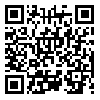Accepted Articles
Back to the articles list |
Back to browse issues page
Seyedeh Jalaleh Zareh Ehsanbakhsh1 
 , Fereshteh Mir Mohammadrezaei1
, Fereshteh Mir Mohammadrezaei1 
 , Mohammad Karimian *2
, Mohammad Karimian *2 
 , Akbar Akbar Hajizadeh Moghaddam1
, Akbar Akbar Hajizadeh Moghaddam1 


 , Fereshteh Mir Mohammadrezaei1
, Fereshteh Mir Mohammadrezaei1 
 , Mohammad Karimian *2
, Mohammad Karimian *2 
 , Akbar Akbar Hajizadeh Moghaddam1
, Akbar Akbar Hajizadeh Moghaddam1 

1- Department of Biology, Faculty of Science, University of Mazandaran, Babolsar, Mazandaran, Iran
2- Department of Cellular and Molecular Biology, Faculty of Science, University of Mazandaran, Babolsar, Mazandaran, Iran
2- Department of Cellular and Molecular Biology, Faculty of Science, University of Mazandaran, Babolsar, Mazandaran, Iran
Abstract: (267 Views)
various implications, including disorders in the female reproductive system. This study aimed to investigate the expression of key steroidogenesis pathway genes, including Cy11a1, Cyp17a1, and Cyp19a1, in the ovaries of adult mice treated with toluene. This was accompanied by histological and bioinformatics analyses.
Methods: For this purpose, 24 adult female mice were divided into three groups of eight: 1-control group, 2- sham group, and 3- toluene group, which received 100 mg/kg of toluene. After the treatments and isolation of the mice ovaries, gene expression analysis was performed using real-time PCR, and histological analysis was conducted with hematoxylin-eosin staining. Molecular docking was also employed to investigate the interaction of toluene with Cyp11a1, Cyp17a1, and Cyp19a1.
Results: Our data showed that toluene exposure could lead to approximately a 45-fold reduction in Cyp19a1 gene expression compared to the sham group (P< 0.001). Furthermore, our histological examinations revealed that the toluene-exposed group had a significant decrease in the number of primary follicles compared to the sham group (P< 0.01). Based on preliminary evidence, bioinformatics analyses suggested that toluene may interact with the central cavity of all three proteins.
Conclusion: Toluene can disrupt ovarian structure and function by altering the expression of key genes involved in steroidogenesis and folliculogenesis. This indicates that exposure to this chemical compound may have adverse consequences on fertility and reproductive health.
Methods: For this purpose, 24 adult female mice were divided into three groups of eight: 1-control group, 2- sham group, and 3- toluene group, which received 100 mg/kg of toluene. After the treatments and isolation of the mice ovaries, gene expression analysis was performed using real-time PCR, and histological analysis was conducted with hematoxylin-eosin staining. Molecular docking was also employed to investigate the interaction of toluene with Cyp11a1, Cyp17a1, and Cyp19a1.
Results: Our data showed that toluene exposure could lead to approximately a 45-fold reduction in Cyp19a1 gene expression compared to the sham group (P< 0.001). Furthermore, our histological examinations revealed that the toluene-exposed group had a significant decrease in the number of primary follicles compared to the sham group (P< 0.01). Based on preliminary evidence, bioinformatics analyses suggested that toluene may interact with the central cavity of all three proteins.
Conclusion: Toluene can disrupt ovarian structure and function by altering the expression of key genes involved in steroidogenesis and folliculogenesis. This indicates that exposure to this chemical compound may have adverse consequences on fertility and reproductive health.
| Rights and permissions | |
 |
This work is licensed under a Creative Commons Attribution-NonCommercial 4.0 International License. |




